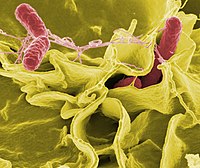
Photo from wikipedia
The antimicrobial properties of Pelargonic acid (PA), a component of tomatoes, makes it an attractive candidate as a food additive and sanitizer. The antimicrobial efficacy of PA emulsions generated using… Click to show full abstract
The antimicrobial properties of Pelargonic acid (PA), a component of tomatoes, makes it an attractive candidate as a food additive and sanitizer. The antimicrobial efficacy of PA emulsions generated using surfactants: Tween 80, Triton X100, Sodium Dodecyl Sulfate (SDS) and Quillaja Saponin was evaluated against Salmonella serotypes Newport, Oranienburg and Typhimurium. Micelle/dropletsize, and minimal inhibitory concentrations (MIC) were determined. Surfactant type and concentration significantly influenced the antimicrobial efficacy of PA (p < 0.05). Overall, Salmonella Newport was the most (p < 0.05) susceptible serotype to PA emulsions. PA emulsions generated with 1.00% SDS had the highest (p < 0.05) antimicrobial activity, with MIC of 7.82 mM against S. Newport and 15.62 mM against S. Oranienburg/S. Typhimurium, respectively. Addition of PA to Trypticase Soy Broth resulted in a decreased growth rate and an increased lag phase duration. Cells exposed to PA formed elongated filaments (>5 µm). Additionally, Salmonella serotypes Typhimurium and Newport also formed floccular biofilms. PA emulsions at a concentration of 31.25 mM generated using 1% SDS and 1% Quillaja saponin resulted in >6 log CFU/ml reduction in Salmonella population. Althought all PA emulsions evalauted inhibited Salmonella, morphological changes to this antimicrobial varied substantially among the Salmonella serotypes tested.
Journal Title: Scientific Reports
Year Published: 2020
Link to full text (if available)
Share on Social Media: Sign Up to like & get
recommendations!